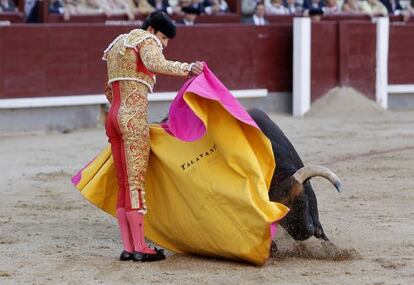TVE brings bullfights back in a move to appeal to lost viewers
Banned spectacle to be aired again six years later to sate “Spanish aficionados”

Bullfighting is set to return to Televisión Española (TVE) after a six-year absence. On September 5, the state-owned station will provide live coverage of a fight at Valladolid, featuring the matadors El Juli, Manzanares and Talavante.
The public broadcaster has reached a deal with the bullfighters, their managers, the rancher Victoriano del Río (whose bulls will be fought) and the Valladolid impresario Antonio Matilla, by virtue of which everyone gives up their rights, meaning that TVE will only have to pay for the technical costs of covering the fight.
TVE justified the decision to air bullfighting again (after it had been banned from doing so when the Socialist Party was in power) by saying that “a celebration of this category must be made available to all Spanish aficionados.”
On the other hand, El Juli, Manzanares and Talavante want to help the state broadcaster go back to airing fights, according to Mesa del Toro, an association that brings together bullfighters, managers, impresarios and ranchers.
The station also said that the Valladolid fight will be the first in “a brief but symbolic series of taurine festivities” that will be aired over the coming months, although no dates have been specified yet.
Minimal costs
TVE’s decision comes at a particularly critical moment for the world of bullfighting. The economic crisis has emptied out the rings and notably reduced the number of programmed fights because of tighter public and private budgets. According to Interior Ministry figures, between 2007 and 2010 the number of bullfights fell by 34.5 percent.
To this must be added several political decisions contrary to bullfighting in emblematic locations. The Basque city of San Sebastián, now run by the radical pro-independence coalition Bildu, has shown its opposition by failing to renew the city ring’s contract for 2013; meanwhile, the Constitutional Court is due to rule on Catalonia’s ban on bullfighting, approved in 2010.
Even though Televisión Española asserts that the costs of covering bullfights are minimal, this new type of programming does not come at a good time for the public broadcaster. The budget cuts of 204 million euros approved by the Popular Party government have meant that it is touch and go whether many series and programs will go back on the air this coming season, and the station has had to resort to archive material this summer to cover programming hours.
The most obvious result of this is a constant drop in audience share for the La 1 channel since March, when Telecinco became the most viewed television station. Last July, La 1 held third spot with an audience share of 10.7 percent, compared with 13.3 percent for Telecinco and 12.7 percent for Antena 3.
Tu suscripción se está usando en otro dispositivo
¿Quieres añadir otro usuario a tu suscripción?
Si continúas leyendo en este dispositivo, no se podrá leer en el otro.
FlechaTu suscripción se está usando en otro dispositivo y solo puedes acceder a EL PAÍS desde un dispositivo a la vez.
Si quieres compartir tu cuenta, cambia tu suscripción a la modalidad Premium, así podrás añadir otro usuario. Cada uno accederá con su propia cuenta de email, lo que os permitirá personalizar vuestra experiencia en EL PAÍS.
¿Tienes una suscripción de empresa? Accede aquí para contratar más cuentas.
En el caso de no saber quién está usando tu cuenta, te recomendamos cambiar tu contraseña aquí.
Si decides continuar compartiendo tu cuenta, este mensaje se mostrará en tu dispositivo y en el de la otra persona que está usando tu cuenta de forma indefinida, afectando a tu experiencia de lectura. Puedes consultar aquí los términos y condiciones de la suscripción digital.








































